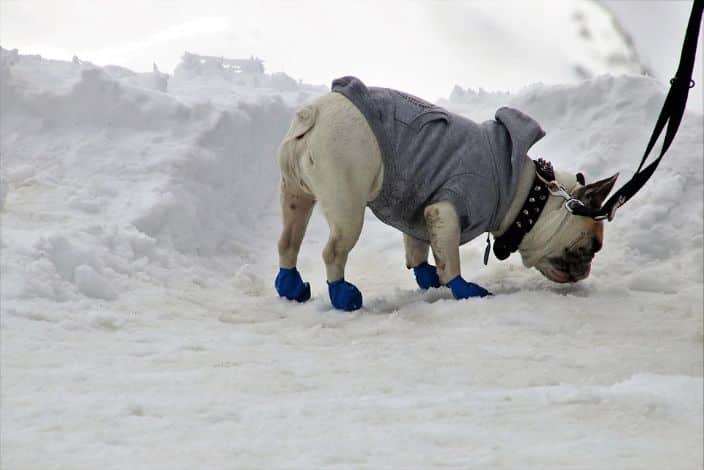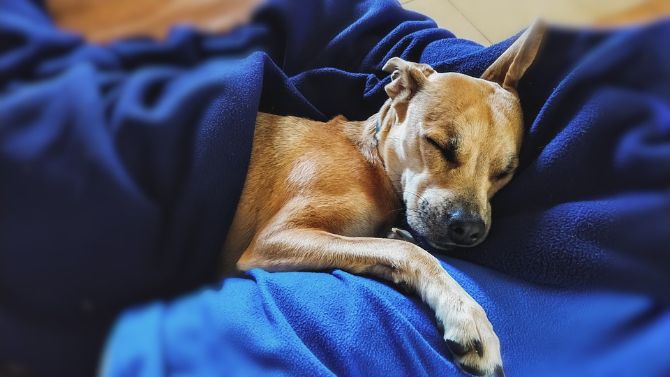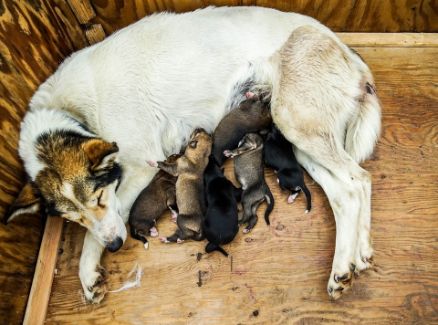We're an affiliate
We hope you love the products we recommend! Just so you know, we may collect a share of sales or other compensation from the links on this page at no additional cost to you. Thank you if you use our links, we really appreciate it!
Everyone has a special bedtime ritual before going to dreamland, which is also done by our canine furbabies but why do dogs dig in their beds?
If you ever notice your dog scratching, pawing, or even voting his bed before going into slumber, it may seem like a weird ritual.
Several dog owners wonder why dogs dig their beds, and most of the time, they do it after they circle their beds. It’s a behavior called denning that is caused by instinct. Although our dogs are now domesticated, their DNA still runs this kind of behavior from their ancestors.
Denning is normal and natural for all dogs. Denning results from dogs’ instinct to sleep in comfort and in protected areas, and many factors can trigger this bedtime ritual in your furbaby.
Why Do Dogs Dig in their Beds
If you ever witness your dog digging into his bed or different areas at your home, you should not be concerned. Chances are your dog’s behavior is due to the following reasons.
1. Body Temperature Regulation
Do you notice that your dog pants when the day is hotter? That’s because their sweat glands are different from that of humans. Panting is their way to control their temperature, cooling them down when needed.
For most wild dogs, one way to cool down is to dig up holes and lie down there to control their temperature.
A small hole in the ground will provide coolness on a hot day since the dug-up soil is lower in temperature than that of the land directly exposed to the sun.
During colder days, a dug-up hole will help in radiating a dog’s body heat. This is similar to how comforters work, a human’s body heat will radiate beneath the comforter, providing generated internal heat. The hole also nestles around a dog’s body, protecting it from the cold wind.

Meanwhile, for our pet dogs, it is believed that they are trying to stir their bedding to make it cooler, similar to the way humans fluff and flip pillows to the other cooler side before laying down.
Lastly, being nestled underneath their blankets allows them to be camouflaged, making them feel secure and protected.
2. Digging Provides Safety
As house pets, our furbabies do not have to worry about predators while they are asleep. However, worrying about their surroundings while still asleep is an ingrained trait that has been passed down for thousands of years.
Not surprisingly, there are dog breeds closely related to wild wolves, such as a Husky and a Pekinese.

This inherited cautiousness is the reason why dogs walk in circles before digging into it. This behavior is one more protective instinct modern dogs inherited from their ancestors to check if there is anything dangerous hiding underneath.
Once dogs get into their bed, they often burrow down deep, allowing them to be less visible, which is essential in the wild.
Less visibility means more peaceful sleep and fewer worries about predators. Fortunately, our furbaby does not need to hide from enemies at home, but they’ll feel the urge to dig before sleeping.
3. To Transfer Their Doggy Scent
Most people associate peeing on surfaces as a dog’s way to mark its territory. Contrary to popular belief, dogs have other means to mark their territory, and it includes denning.
Dogs have glands in their paw pads that excrete their unique scent. This means when they paw at something; those glands begin to leak, leaving behind their smell. So when a dog starts scratching and digging into their bed, they leave behind their mark and announce to any surrounding pets that it’s theirs.

If another pet trespasses, it can cause your dog to become anxious. Anxious dogs can often overreact to small unwanted interactions, so it is best to keep an eye on your furbaby when others are around if you see any signs of aggression. Some things to watch for are raised hair, teeth-baring, low growling, or tense posture.
4. Dogs Dig at Their Beds to Hide
When a dog is nervous, scared, or stressed, their primary defense mechanism is to hide. It is an ancient instinctual behavior that they are not consciously doing.
If your dog is digging into her bed, it might be due to anxiety or fear, consider moving your furbaby’s bed into a quieter area. At the same time, try to soothe her by giving slow strokes and soft whispering.

Some dog breeds become nervous when there’s too much activity in their sleeping area, and small dogs are more scared of this.
When your pet becomes nervous more often, it can lead to aggression if they feel threatened. Humans and dogs alike, who have suffered from anxiety attacks, know that even the slightest perceived threat can make you panic if there isn’t any real danger.
Hiding is an instinctual behavior for dogs derived from their ancestors to protect themselves from various dangers such as predators.
You might see your dog digging away at his bed, even if there are no blankets when you have visitors or a new pet is brought home.
5. Pregnant Dogs Dig For Nesting
Nesting is a familiar occurrence when a female dog is pregnant. This behavior exists across species, including dogs and humans.
The nesting phase is the stage in an expecting mother’s pregnancy, where they may feel the extreme urge to prepare for their baby’s arrival. These urges can include physical tasks such as cleaning the house, putting the final touches on the nursery, and doing laundry.
Expecting canine mothers have their version of nesting. You will often see pregnant dogs digging at the spot they are about to lie in.
This is a mother’s instinctual behavior to prepare the “nest” for her upcoming litter, even if they’re not due for a while. They will “dig” enough space for their puppies’ comfort.

Some non-pregnant female dogs also do this because of instincts and false feelings that they are pregnant.
6. For Comfort
Who does not want comfortable bedding when they sleep, right? We want to doze off in comfort, otherwise, why lay down on beds? Who doesn’t shift a hundred times, fluff our pillows, or rearrange blankets before we can finally be still? It takes a while to find the perfect sleeping position for humans and dogs alike.

Dogs are just similar to people when it comes to comfort. They want to be comfortable when they lay down. So they may dig into fluffing their bed into the right spot or positioning the bed filling correctly.
7. For Safekeeping
If you remember a scene from cartoons where a dog buries a bone in the backyard alongside other precious items such as toys and other bones, it shows that dogs have the urge to hide essential things for safekeeping.
In the wild, dogs often bury food for later. This is useful during the winter months when food is scarce. As a result, domesticated dogs often hide their treasured items, similar to their ancestors.
If they don’t have access to a safe area outside, your furbaby might designate places indoors, including her bed.

If you notice your furbaby digging right after receiving a treat, you might want to look at where they are heading.
He might be bringing the treat to his bed and hiding it underneath. This isn’t a bad thing, as long as the stuff your dog is hiding is not perishable.
Laura is the founder of Furs'n'Paws. She is a also a pet writer and expert with more than 20 years of experience of working with dogs and cats. She developed a very strong love for animals at a young age. Her passion led her to establish a thriving pet sitting and dog walking business in Dubai. As an expert in pet training, behavior, and nutrition, Laura is committed to helping pet owners and pet lovers by offering high-quality information on a wide range of topics.



No responses yet